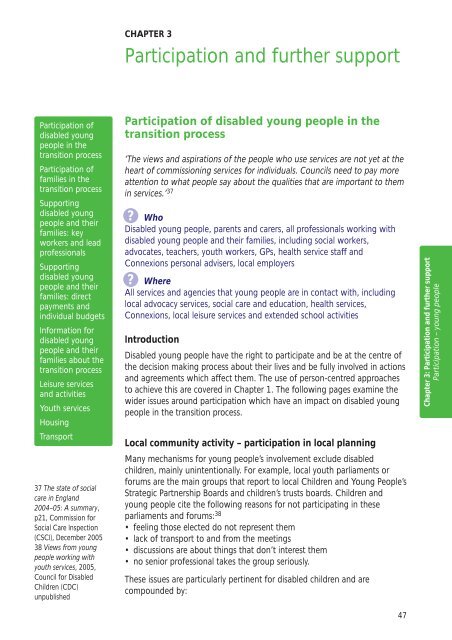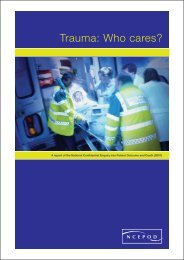A Transition Guide for All Services - Transition Information Network
A Transition Guide for All Services - Transition Information Network
A Transition Guide for All Services - Transition Information Network
- No tags were found...
Create successful ePaper yourself
Turn your PDF publications into a flip-book with our unique Google optimized e-Paper software.
CHAPTER 3Participation and further supportParticipation ofdisabled youngpeople in thetransition processParticipation offamilies in thetransition processSupportingdisabled youngpeople and theirfamilies: keyworkers and leadprofessionalsSupportingdisabled youngpeople and theirfamilies: directpayments andindividual budgetsIn<strong>for</strong>mation <strong>for</strong>disabled youngpeople and theirfamilies about thetransition processLeisure servicesand activitiesYouth servicesHousingTransport37 The state of socialcare in England2004–05: A summary,p21, Commission <strong>for</strong>Social Care Inspection(CSCI), December 200538 Views from youngpeople working withyouth services, 2005,Council <strong>for</strong> DisabledChildren (CDC)unpublishedParticipation of disabled young people in thetransition process‘The views and aspirations of the people who use services are not yet at theheart of commissioning services <strong>for</strong> individuals. Councils need to pay moreattention to what people say about the qualities that are important to themin services.’ 37?WhoDisabled young people, parents and carers, all professionals working withdisabled young people and their families, including social workers,advocates, teachers, youth workers, GPs, health service staff andConnexions personal advisers, local employers?Where<strong>All</strong> services and agencies that young people are in contact with, includinglocal advocacy services, social care and education, health services,Connexions, local leisure services and extended school activitiesIntroductionDisabled young people have the right to participate and be at the centre ofthe decision making process about their lives and be fully involved in actionsand agreements which affect them. The use of person-centred approachesto achieve this are covered in Chapter 1. The following pages examine thewider issues around participation which have an impact on disabled youngpeople in the transition process.Local community activity – participation in local planningMany mechanisms <strong>for</strong> young people’s involvement exclude disabledchildren, mainly unintentionally. For example, local youth parliaments or<strong>for</strong>ums are the main groups that report to local Children and Young People’sStrategic Partnership Boards and children’s trusts boards. Children andyoung people cite the following reasons <strong>for</strong> not participating in theseparliaments and <strong>for</strong>ums: 38• feeling those elected do not represent them• lack of transport to and from the meetings• discussions are about things that don’t interest them• no senior professional takes the group seriously.These issues are particularly pertinent <strong>for</strong> disabled children and arecompounded by:47Chapter 3: Participation and further supportParticipation – young people
















